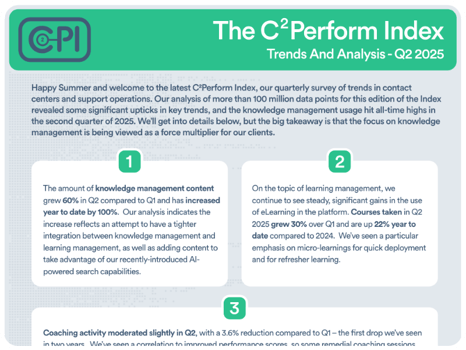Effective internal communication (IC) is the lifeblood of successful customer support operations. In the fast-paced world of contact centers and customer support operations, miscommunication can hurt productivity, revenue, and customer success.
Yet, strong internal communication and team coordination are often come up as top challenges in industry surveys by Gallup and Forrester. They report that globally only 24% of employees feel actively engaged.
Whether your workforce is remote, hybrid, or on-site, a strategic communication framework ensures everyone stays aligned, engaged, and empowered to deliver exceptional service.
Let’s explore the best practices and real-world examples into seven actionable tips—backed by data and experience—to help you transform ad-hoc messaging cadence into a scalable, trust-building communication culture.
What is Internal Communication?
Internal communications are much more than just keeping your employees “in the loop.” IC means you have a framework in place to keep your employees and company strategy aligned. IC happens through multiple channels and flows through your entire organization.
Internal communication goes beyond merely keeping employees informed. It's about creating a framework that supports clarity, fosters collaboration, and improves employee morale. For instance, some real-world examples of effective internal communication include:
- Regular team check-ins via video calls to ensure clarity of daily goals.
- Executive town halls for transparent leadership communication.
- Employee recognition shared across social news feeds or dedicated channels.
Why Does Strong Internal Communication Matter?
Good communication underpins every aspect of high-performing support teams. According to Gallup, organizations with highly engaged employees report 21% higher profitability. Clear, consistent messaging reduces errors, accelerates decision-making, and fosters a sense of belonging—critical drivers of retention and customer loyalty.
Effective team communication can help your contact center employees feel more engaged in the workplace. Communication management is more important than ever before—especially as more and more team members go remote and work from home.
Only 44% feel like they have clear direction from senior leaders. Contact centers aren’t immune to this disengagement crisis. Work environments continue to change and develop in a post-pandemic landscape–which means it’s going to take a bit more than a few additional employee meetings to keep your team engaged.
Highly engaged employees are five times less likely to quit their jobs, something all business leaders should keep in mind in wake of The Great Resignation. Engaged employees are more productive as well. And, employee engagement can trickle down to help create added customer loyalty through more positive call center-to-customer interactions.
What Are Some Common IC Challenges in Support Operations?
Every support leader encounters communication roadblocks. Recognize these signals in your organization:
- Channel Overload: Important updates lost amid email, chat, and calls.
- Delayed Feedback: Performance issues escalate due to slow coaching loops.
- Knowledge Silos: Teams don't incorporate knowledge hubs, repeating avoidable mistakes.
- One-Size-Fits-All Announcements: Generic messages that miss role-specific needs.
- Recognition Gaps: Lack of timely, visible praise erodes morale.
Example: A healthcare claims team noticed a rise in error rates when critical policy changes were emailed but not reiterated in team huddles.
7 Tips for Improving Employee Communication and Team Coordination
Your internal communication process will be ever-changing and evolving as your company grows. Business needs change and technologies evolve, so be prepared for a lot of cross-department collaboration. Here are seven communication tips to start improving your team coordination.
1. Analyze Your Existing Employee Communication Plan
At this stage, it’s smart to collect employee feedback. You can do this via anonymous surveys where employees can share their honest thoughts and opinions about the processes currently in place.
2. Examine Your Internal Communications Tools
Select a primary tool—such as broadcast messaging—to share urgent updates. Document guidelines on when to use chat vs. email vs. meetings. Tools like C2Perform can help streamline your communications.
3. Implement Daily or Weekly Huddles
Short, focused stand‑ups (5–10 minutes) help surface blockers and align priorities. If your team is fully remote or you use a hybrid model, best practice includes scheduling daily check‑ins via video or chat to maintain employee engagement.
4. Create a Centralized Knowledge Hub
Use a dynamic knowledge base with search, version control, and analytics. For instance, retail support teams reduce repeat inquiries by 30% when FAQs live in one portal.
5. Embed Micro‑Learning & Coaching Prompts
Integrate short training videos or coaching nudges into workflows. A global telecom provider increased eLearning completions by 25% using in‑tool prompts.
6. Get Social!
Recognize employee achievements and milestones through company chats or news feeds to boost morale and engagement. Establish informal channels where leaders and staff can share successes.
7. Tailor Messages by Team & Role
Segment announcements so content is relevant to each group. Companies notice increases in message open rates and responses by targeting leadership, support, and tech teams separately.
And a couple of Bonus Pointers:
Evaluate (or Establish) Your Approval Process
Do your internal communications need approval? Some communications may need sign off from executives or heads of specific departments. Even if you have an employee in charge of managing internal communications, team coordination falls on every single employee from the top down.
Having a standard operating procedure for your approval process will help prevent errors in your process. Some things to consider are:
- Who manages your internal communications?
- Who on your marketing team (if you have a marketing team) will write internal communications materials?
- What other teams might need to be involved in internal messaging? How will they contribute?
Optimize Based On Evaluations
Once your new internal communication plan is in place, the work doesn’t stop. Continue to collect employee feedback and evaluate your new process. Compare it to your initial evaluation to see if there are still any areas for improvement.
Not all platforms are created equal. Look for solutions that combine:
- Instant Broadcast Messaging with read receipts
- Integrated LMS & Knowledge Management features
- Recognition & Gamification modules
- Coaching & Feedback Workflows built into agent dashboards
Tip: Before adopting new software, run a pilot with a cross-functional team to validate usability and impact.
Open-ended questions that you should continue to ask your employees include:
- How can we improve on company communications?
- What is your preferred method of employee communication?
- Do you find our company goals and mission to be transparent? Why or why not?
- What roadblocks do you face when it comes to internal communication?
- Are there any tools you’d find beneficial for internal communications?
Plus, if you continue to implement employee feedback, they’ll feel more engaged and heard.
Why Trust C2Perform for Communication Strategies?
With more than a decade supporting global organizations, C2Perform provides solutions that facilitate seamless internal communication and team coordination. C2Perform is built by practitioners who’ve led support operations. Our tools help managers and employees remain aligned without unnecessary admin.
Our all-in-one platform unifies messaging, knowledge, coaching, and recognition—eliminating silos and driving consistency. Organizations in 30+ countries rely on us to simplify communication, improve engagement, and accelerate issue resolution.
Get Started on Improving Employee Communications
Having the right tools can make or break your internal communications plan, even with a solid plan in place. C2Perform offers a full suite of tools for employee engagement and performance management, all in one software platform. Schedule a discovery call with us today to see how C2Perform can help improve your employee communications and grow your business.
 English
English Español
Español





.png?height=350&name=Untitled%20(300%20x%20175%20px).png)



